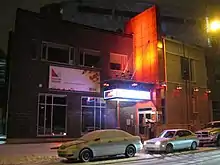Ontario Street (Montreal)
Ontario Street (officially in French: rue Ontario) is an east-west artery in Montreal, Quebec, Canada. It crosses the boroughs of Ville-Marie and Mercier–Hochelaga-Maisonneuve. It is in the latter that the street becomes predominantly commercial and is known as Promenade Ontario.
 Rue Ontario | |
| Native name | French: Rue Ontario |
|---|---|
| Part of | Ville-Marie, Mercier–Hochelaga-Maisonneuve |
| Length | 6.1 km (3.8 mi) |
| Location | Between Sherbrooke Street and Sainte-Catherine Street |
| From | Saint-Urbain |
| To | Rue Ida-Steinberg |
Two metro stations are located on Ontario Street: Place des Arts and Frontenac. The STM runs the 125 bus along this street.
President Kennedy Avenue
Ontario Street is called President Kennedy Avenue (French: avenue du Président-Kennedy) west of Saint-Urbain Street in Downtown Montreal. President Kennedy Avenue is home to various hotels and condominiums. This portion of the street is named after the 35th U.S. President, John F. Kennedy.

History
John S. Cartwright, a banker from Kingston, Ontario and J. B. Forsyth, a local merchant, purchased and subdivided the farm of Sir John Johnson in the north part of the Faubourg Quebec. They gave the three new streets the names of three different Great Lakes: Erie, Huron and Ontario. Ontario Street was later extended in stages toward both the east and west. Until 1948, it was believed that the street was named after the province of Ontario, but the discovery of the subdivision documents by a city of Montreal historian corrected this inaccuracy. Although it had been known as Ontario Street since 1842, the name was made official in 1867.
The neighbourhoods that the street crosses, the Centre-Sud and Hochelaga-Maisonneuve, fell into economic decline by the 1980s, leading to many closed businesses and a high poverty rate.
The street has long been known for prostitution, especially the eastern segment.[1][2][3]
Since the 2010s the street has gentrified considerably, in part due to the expansion of the village on the downtown section of the street, and the Promenade Ontario shopping area in Hochelaga-Maisonneuve, which becomes pedestrian in the summer.[4][5][6]
In popular culture
It is the subject of Bernard Adamus's Rue Ontario, a 2010 single that portrays the street generally unfavorably.[7]
The street is also the focus of Richard Beaulieu’s Chroniques du Centre-Sud, a 2014 graphic novel.[8]
See also
Further reading
- Ville de Montréal. Les rues de Montréal. Répertoire historique. Montréal,Méridien, 1995, p. 360
References
- Forget, Dominique (8 May 2013). "Mon quartier me rend malade" (in French). Montreal: L'Actualité. Retrieved 22 November 2020.
- "Une nuit avec Capone" (in French). Montreal: La Presse. 26 October 2009. Retrieved 4 January 2021.
- Hamelin, Louis (1991). Ces Spectres Agités (in French). BOREAL. p. 60-62. ISBN 9782764620571.
- "Le droit au quartier". Montreal: Actualités UQAM. 11 December 2018. Retrieved 10 December 2020.
- "L'évolution de la Promenade Ontario: un indicateur". Montreal: Carle Bernier-Genest. 22 June 2015. Retrieved 10 December 2020.
- "La rue Ontario sera piétonne cet été". Montreal: Journal Métro. 22 June 2020. Retrieved 10 December 2020.
- https://www.youtube.com/watch?v=AmhskszxZF4 Rue Ontario by Bernard Adamus
- Suicide, Richard (March 2014). Chroniques du Centre-Sud (in French). Editions Pow Pow. ISBN 9782924049143.